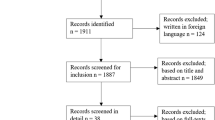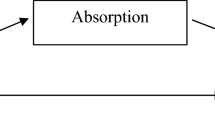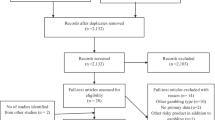Abstract
Structural characteristics of gaming machines contribute to persistence in play and excessive losses. The purpose of this study was to evaluate the effectiveness of five proposed responsible gaming features: responsible gaming messages; a bank meter quarantining winnings until termination of play; alarm clock facilitating setting time-reminders; demo mode allowing play without money; and a charity donation feature where residual amounts can be donated rather than played to zero credits. A series of ten modified gaming machines were located in five Australian gambling venues. The sample comprised 300 patrons attending the venue and who played the gaming machines. Participants completed a structured interview eliciting gambling and socio-demographic data and information on their perceptions and experience of play on the index machines. Results showed that one-quarter of participants considered that these features would contribute to preventing recreational gamblers from developing problems. Just under half of the participants rated these effects to be at least moderate or significant. The promising results suggest that further refinements to several of these features could represent a modest but effective approach to minimising excessive gambling on gaming machines.

Similar content being viewed by others
References
Australian Gaming Council. (2010). A database on Australia’s gambling industry 2009/2010. Melbourne: Australian Gaming Council.
Blaszczynski, A., Sharpe, L., & Walker, M. (2001). The assessment of the impact of the reconfiguration on electronic gaming machines as harm minimisation strategies for problem gambling. Sydney: University of Sydney Gambling Research Unit.
Blaszczynski, A., Sharpe, L., Walker, M., Shannon, K., & Coughlan, M.-J. (2005). Structural characteristics of electronic gaming machines and satisfaction of play among recreational and problem gamblers. International Gambling Studies, 5(2), 187–198.
Brandt, A. E., & Pietra, C. J. (2008). Gambling on a simulated slot machine under conditions of repeated play. Psychological Record, 58(3), 405–426.
Chóliz, M. (2010). Experimental analysis of the game in pathological gamblers: Effects of the immediacy of the reward in slot machines. Journal of Gambling Studies, 26, 249–256. doi:10.1007/s10899-009-9156-6.
Cloutier, M., Ladouceur, R., & Sevigny, S. (2006). Responsible gambling tools: Pop-up messages and pauses on video lottery terminals. Journal of Psychology: Interdisciplinary and Applied, 140, 434–438.
Dickson-Gillespie, L., Rugle, L., Rosenthal, R., & Fong, T. (2008). Preventing the incidence and harm of gambling problems. The Journal of Primary Prevention, 29(1), 37–55.
Diskin, K. M., & Hodgins, D. C. (2001). Narrowed focus and dissociative experiences in a community sample of experienced video lottery gamblers. Canadian Journal of Behavioural Science, 33, 58–64.
Dixon, M. R., & Schreiber, J. E. (2004). Near-miss effects on response latencies and in estimations of slot machine player. Psychological Record, 54(3), 335–348.
Dorion, J. P., & Nicki, R. M. (2001). Epidemiology of problem gambling in Prince Edward Island: A Canadian microcosm. Canadian Journal of Psychiatry, 46, 413–417.
Dowling, N., Smith, D., & Thomas, T. (2005). Electronic gaming machines: Are they the ‘crack-cocaine’ of gambling? Addiction, 100, 33–45.
Ferris, J., & Wynne, H. (2001). The canadian problem gambling index. Ottawa, ON: Canadian Centre on Substance Abuse.
Griffiths, M. D. (1990). The acquisition, development and maintenance of fruit machine gambling in adolescents. Journal of Gambling Studies, 6, 193–204.
Gupta, R., & Derevensky, J. L. (1998). An empirical examination of Jacobs’ general theory of addictions: Do adolescent gamblers fit the theory? Journal of Gambling Studies, 14, 17–49.
Hanson, M., & Rossow, I. (2010). Limited cash flow on slot machines: Effects of prohibition of note acceptors on adolescent gambling behaviour. Journal of Gambling Issues, 23, 81–110.
Hodgins, D. C., Ching, L. E., & McEwen, J. (2009). Strength of commitment language in motivational interviewing and gambling outcomes. Psychology of Addictive Behaviors, 23, 122–130.
Holtgraves, T. (2009). Evaluating the problem gambling severity index. Journal of Gambling Studies, 25, 105–120.
IPART (Independent Pricing and Regulatory Tribunal of New South Wales). (2004). Gambling: Promoting a culture of responsibility. Sydney: Authors.
Jackson, A. C., Wynne, H., Dowling, N. A., Tomnay, J. E., & Thomas, S. (2010). Using the CPGI to determine problem gambling prevalence in Australia: Measurement issues. International Journal of Mental Health and Addiction, 8(4), 570–582.
Jacobs, D. F. (1988). Evidence for a common dissociative-like reaction among addicts. Journal of Gambling Behavior, 4, 27–37.
Ladouceur, R., & Sevigny, S. (2003). Interactive messages on video lottery terminals and persistence in gambling. Journal of the National Association for Gambling Studies, 15, 45–50.
Ladouceur, R., & Sevigny, S. (2006). The impact of video lottery game speed on gamblers. Journal of Gambling Studies, 17.
Ladouceur, R., & Sevigny, S. (2009). Electronic gaming machines: Influence of a clock, a cash display, and a precommitment on gambling time. Journal of Gambling Studies, 23, 31–41.
Ladouceur, R., Blaszczynski, A., & Lalande, D. R. (2012). Pre‐commitment in gambling: A review of the empirical evidence. International Gambling Studies, 12(2), 215–230.
Lalande, D. R., & Ladouceur, R. (2011). Can cybernetics inspire gambling research? A limit-based conceptualization of self-control. International Gambling Studies, 11, 237–252.
Lee, H., Chae, P. K., Lee, H., & Kim, Y. (2007). The five-factor gambling motivation mode. Psychiatry Research, 150, 21–32.
Linnet, J., Thomsen, K. R., Moller, A., & Callesen, M. B. (2010). Event frequency, excitement and desire to gamble among pathological gamblers. International Gambling Studies, 10(2), 177–188.
Livingstone, C., & Woolley, R. (2008). The relevance and role of gaming machines games and game features on the play of problem gamblers. Melbourne: Australian Institute of Primary Care.
MacLin, O., Dixon, M. R., Daugherty, D., & Small, S. L. (2007). Using a computer simulation of three slot machines to investigate a gambler’s preference among varying densities of near-miss alternatives. Behavior Research Methods, 39(2), 237–241.
Monaghan, S. (2008). Review of pop-up messages on electronic gaming machines as a proposed responsible gambling strategy. International Journal of Mental Health and Addiction, 6, 214–222. doi:10.1007/s11469-007-9133-1.
Monaghan, S., & Blaszczynski, A. (2007). Recall of electronic gaming machine signs: A static versus a dynamic mode of presentation. Journal of Gambling Issues, 20, 253–268.
Monaghan, S., & Blaszczynski, A. (2010a). Electronic gaming machine warning messages: Informative versus self-evaluation. Journal of Psychology: Interdisciplinary and Applied, 144(1), 83–96.
Monaghan, S., & Blaszczynski, A. (2010b). Impact of mode of display and message content of responsible gambling signs for electronic gaming machines on regular gamblers. Journal of Gambling Studies, 26(1), 67–88.
Neighbors, C., Lostutter, T. W., Cronce, J. M., & Larimer, M. E. (2002). Exploring college student gambling. Motivation, 18, 361–370.
Nower, L., & Blaszczynski, A. (2010). Gambling motivations, money-limiting strategies, and precommitment preferences of problem versus non-problem gamblers. Journal of Gambling Studies, 26, 361–372.
Productivity Commission. (1999). Australia’s gambling industries. Report No. 10. Canberra, Ausinfo.
Productivity Commission. (2010). Gambling. Productivity Commission Inquiry Report No. 50. Canberra, Ausinfo.
Queensland Office of Regulatory Policy. (2009). Queensland responsible gambling code of practice: Report on the sustainability review. Queensland: Department of Employment, Economic Development and Innovation.
Queensland Treasury and Trade. (2012). Population and dwelling profile. http://www.oesr.qld.gov.au/products/profiles/pop-housing-profiles-lga/pop-housing-profile-gold-coast.pdf. Retrieved 6 March 2013.
Rush, B., Moxam Shaw, R., & Urbanoski, K. (2002). Characteristics of people seeking help from specialized programs for the treatment of problem gambling in Ontario. Electronic Journal of Gambling Issues, 6, 32–54 [Online]. Retrieved from www.camh.net/egambling/issue6.
Skinner, B. F. (1953). Science and human behaviour. New York: Free Press.
Smith, G. J., & Wynne, H. J. (2004). VLT gambling in Alberta: A preliminary analysis. Alberta Gambling Research Institute. Available: www.abgaminginstitute.ualberta.ca/documents/research/VLT_Gambling_Alberta.pdf.
Stucki, A., & Rihs-Middel, M. (2007). Prevalence of adult problem and pathological gambling between 2000 and 2005: An update. Journal of Gambling Studies, 23, 245–257.
Urbanoski, K. A., & Rush, B. R. (2006). Characteristics of people seeking treatment for problem gambling in Ontario: Trends from 1998–2002. Electronic Journal of Gambling Issues, 16, 77–97 [Online]. Retrieved from www.camh.net/egambling/issue16.
Walker, M. B. (1992). The psychology of gambling. Oxford: Pergamon.
Acknowledgments
Aristocrat Technologies provided financial support for the research project to be carried out in several Surf Life Saving Clubs in venues in Queensland. We wish to acknowledge the assistance of managers in allowing access to venues, and to Aristocrat Technologies for providing research funds and technical expertise. We extend our thanks to all the research assistants involved in the data collection phase of the research, and Adele de Jager for data input.
Conflict of interest
Aristocrat Leisure Industries provided financial and technical support for this study, and venue managers collaborated by allowing modified electronic gaming machines to be located on their premises. The Queensland Government’s Office of Liquor, Gaming and Racing, provided regulatory approval for the modification and installation of electronic gaming machines into venues.
Author information
Authors and Affiliations
Corresponding author
Rights and permissions
About this article
Cite this article
Blaszczynski, A., Gainsbury, S. & Karlov, L. Blue Gum Gaming Machine: An Evaluation of Responsible Gambling Features. J Gambl Stud 30, 697–712 (2014). https://doi.org/10.1007/s10899-013-9378-5
Published:
Issue Date:
DOI: https://doi.org/10.1007/s10899-013-9378-5




